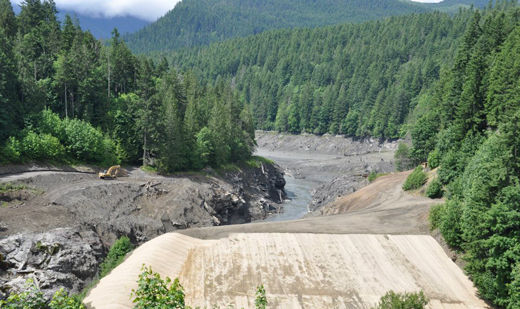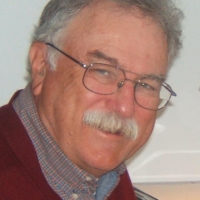
PORT ANGELES, Wash. – For 100 years, two hydroelectric dams on the Elwha River blocked fish from their spawning grounds, destroying one of the world’s most bountiful salmon fisheries.
Now construction workers have blasted the concrete dams, removed the rubble, and slowly drained the lakes. The river is once again running free, flowing from its headwaters high in the Olympic Mountains to the Strait of Juan de Fuca. Most thrilling of all is that the Chinook, Coho, Chum, Silver, and Sockeye salmon and the Steelhead trout have appeared above the Elwha dams for the first time in a century.
The two dams, the lower Elwha Dam and eight miles upstream, the Glines Canyon Dam, were built in 1910 to provide electricity for a paper mill. Surplus electricity was sold to the city of Port Angeles. No fish-ladder was built so 400,000 or more salmon and steelhead were confined to the short stretch of the stream below the dams. A deal to build a fish hatchery to replace the upstream spawning beds ended after nine years, when the private owners closed the hatchery down.
It was a disaster for the salmon, and also for the Lower Elwha Klallam Tribe, who make their home on the river banks, drawing their sustenance from the salmon and steelhead.
“It messed up our diet; our way of getting food,” said Robert Elofson, Elwha River Restoration Director for the Lower Elwha Klallam Tribe. The tribe ate the salmon, he added, and sold the surplus in Port Angeles and other markets, a mainstay of their economy. Now that lifeline was gone.
“When we first made the motion for dam removal, we did not have the support of any federal agency,” Elofson told the People’s World. “We did have the support of many environmental groups.”
Finally, in 1992, the Klallam Tribe won passage of a federal act to remove the dams. Yet it took until 2009, another seventeen years, for Congress to approve the money to move ahead. Now, the dams are gone; the last concrete remnants are due to be removed by 2014.
Workers have cut a trail through the deeply forested slopes of the Elwha River canyon to a viewpoint where thousands of tourists can look down on the open, fast-flowing Elwha where the lower dam once stood. Much of the $325 million for the project came from President Obama’s economic stimulus package, including the $16.4 million for a new fish hatchery that Elofson called “state of the art” – probably, he said, “the best one in Washington State right now.”
Elofson is a trained biologist who has devoted his life to the restoration of the river. While we were speaking, he received a call on his cellphone from his son who operates a fishing boat in the Strait of Juan de Fuca and the Pacific Ocean.
“Eighty-seven percent of the Elwha watershed is in the Olympic National Park,” Elofson continued. “We own the first mile of the river and the near shore. We know it is one of the best-protected streams in America. The sediment transport has followed the modeling very well. We already have adult salmon and steelhead swimming up above where the first dam used to stand. They are spawning in Little River, a tributary of the Elwha.
“The tribe also physically moved some adult Coho salmon into Little River and Indian Creek. We had 100 hatchlings from the redds (spawning nests) – 60 redds in Little River and 30 redds in Indian Creek. These fish have not been up there for 100 years, yet they liked the river there and they spawned in those streams.”
“We expect the restoration of the Elwha to be very successful. We’re not sure about the length of time it will take. But all the signs are good.”
It is the biggest dam removal project in U.S. history, he said, one of the biggest infrastructure projects in President Obama’s economic stimulus program.
There is also a dam removal project on the Klamath River in southern Oregon, Elofson said. “And there is a proposal to remove two dams on the Penobscot River in Maine.”
On the other hand, in Alaska, the Anglo-American Corporation plans to dig the Pebble Mine an enormous open pit three and a half miles across and a mile deep, destroying spawning beds for the world’s richest Sockeye salmon fishery. The pristine waters of the rivers that empty into Bristol Bay would run red with arsenic and other toxic chemicals in mining the gold and copper. Pitted against this ruthless corporate greed are the Native American Indians of Alaska, the fishermen, and the environmentalists.
So far, said Elofson, the Elwha Restoration Project “has created some jobs in construction and will create more jobs in the future. We have tribal fishing rights to harvest the salmon. There are only about 5,000 salmon coming back now but we expect between 300,000 and 400,000 when the river is fully restored. Half of these runs will be harvestable.” It will be a new day for the Klallam tribe and for the salmon.
Photo: Susan Wheeler/PW

MOST POPULAR TODAY

High Court essentially bans demonstrations, freedom of assembly in Deep South

Zionist organizations leading campaign to stop ceasefire resolutions in D.C. area

UN warns that Israel is still blocking humanitarian aid to Gaza


U.S. imperialism’s ‘ironclad’ support for Israel increases fascist danger at home






Comments